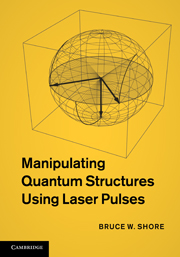Book contents
- Frontmatter
- Contents
- Preface
- Acknowledgments
- 1 Introduction
- 2 Atoms as structured particles
- 3 Radiation
- 4 The laser–atom interaction
- 5 Picturing quantum structure and changes
- 6 Incoherence: Rate equations
- 7 Coherence: The Schrödinger equation
- 8 Two-state coherent excitation
- 9 Weak pulse: Perturbation theory
- 10 The vector model
- 11 Sequential pulses
- 12 Degeneracy
- 13 Three states
- 14 Raman processes
- 15 Multilevel excitation
- 16 Averages and the statistical matrix (density matrix)
- 17 Systems with parts
- 18 Preparing superpositions
- 19 Measuring superpositions
- 20 Overall phase; interferometry and cyclic dynamics
- 21 Atoms affecting fields
- 22 Atoms in cavities
- 23 Control and optimization
- Appendix A Angular momentum
- Appendix B The multipole interaction
- Appendix C Classical radiation
- Appendix D Quantized radiation
- Appendix E Adiabatic states
- Appendix F Dark states; the Morris–Shore transformation
- Appendix G Near-periodic excitation; Floquet theory
- Appendix H Transitions; spectroscopic parameters
- References
- Index
Appendix F - Dark states; the Morris–Shore transformation
Published online by Cambridge University Press: 07 October 2011
- Frontmatter
- Contents
- Preface
- Acknowledgments
- 1 Introduction
- 2 Atoms as structured particles
- 3 Radiation
- 4 The laser–atom interaction
- 5 Picturing quantum structure and changes
- 6 Incoherence: Rate equations
- 7 Coherence: The Schrödinger equation
- 8 Two-state coherent excitation
- 9 Weak pulse: Perturbation theory
- 10 The vector model
- 11 Sequential pulses
- 12 Degeneracy
- 13 Three states
- 14 Raman processes
- 15 Multilevel excitation
- 16 Averages and the statistical matrix (density matrix)
- 17 Systems with parts
- 18 Preparing superpositions
- 19 Measuring superpositions
- 20 Overall phase; interferometry and cyclic dynamics
- 21 Atoms affecting fields
- 22 Atoms in cavities
- 23 Control and optimization
- Appendix A Angular momentum
- Appendix B The multipole interaction
- Appendix C Classical radiation
- Appendix D Quantized radiation
- Appendix E Adiabatic states
- Appendix F Dark states; the Morris–Shore transformation
- Appendix G Near-periodic excitation; Floquet theory
- Appendix H Transitions; spectroscopic parameters
- References
- Index
Summary
A simple redefinition of the quantization axis can change the linkage pattern of a linearly polarized field from one in which only pairs of state are linked (e.g. quantization axis along the linear polarization direction) to one in which several states are linked, with consequences such as those discussed in Sec. 12.4. The change of linkage pattern accompanies a redefinition of the basis states. It is natural to wonder whether a suitable change of basis can reduce other linkage patterns into ones in which only pairs of states are linked. If so, then one might make use of the very simple analytic solutions for two-state systems in treatments of more elaborate systems. Such simplification is possible under some conditions [Sho08]. The procedure involves a change of basis states known as a Morris–Shore (MS) transformation [Mor83; Vit00a; Vit03; Kis04; Iva06; Ran06].
The Morris–Shore transformation
An interaction pattern comprising multiple linkages can, when the pattern satisfies appropriate conditions, be replaced by a set of independent two-state interactions. The necessary conditions are [Mor83]
I. Two sets of states:
Set A (initial, ground), with NA elements.
Set B (excited), with NB elements.
II. There are no couplings within the A set or the B set, only couplings between A and B. (The graph corresponding to this linkage pattern is therefore bipartite.)
III. The two sets share common diagonal elements. In the RWA these are the two detunings ΔA and ΔB.
- Type
- Chapter
- Information
- Manipulating Quantum Structures Using Laser Pulses , pp. 522 - 527Publisher: Cambridge University PressPrint publication year: 2011

